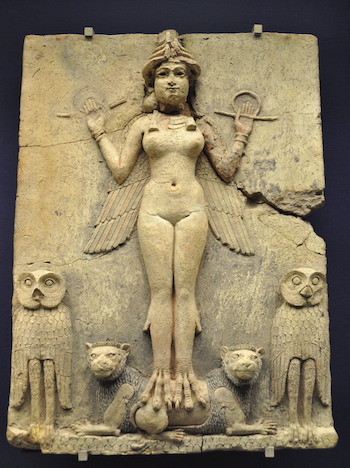It was accidental. I was in my local theological library, rooting around in the dusty stacks for images of talisman and magical objects from the Middle Ages.
The history of talisman is amazing and would make for one sweet coffee table book. There’s magical objects for every purpose, every occasion, sort of like the state of apps for smartphones today. Anyhow, I came across reference to a 1910 article describing a modern (late 19th century) Hebrew talisman described as “Kabbalistic.”

I was piqued so I downloaded the article. I was delighted to read the translation, “In the name of the angels of the God (of Israel) I conjure you all kinds of Lilin, male and female,and Demons, male and female by the power of the holy Name.”
Lilin are a host of night demons that are first mentioned in Babylonian seals some eighteen hundred years before the Common Era. Much, much later came the Judaic tradition of Lilith: the owl-footed half human demoness who steals upon men at night and sexually assaults them in order to create demon-human hybrid babies.

Lilith and Lilin were blamed for the unexplained death of infants at night (probably related to what we call SIDS today)… and also for the terrible plague of supernatural assault that was termed the Incubus in the middle ages.
Holy cow, I realized, this could be a sleep paralysis amulet.
I reviewed my copy of Shelly Adler’s wonderful book Sleep Paralysis: Night-mares, Nocebos, and the Mind-Body Connection, where she details the connections of Lilith to our favorite night malady.
This mention from the Talmud rings with authenticity: “One must not sleep in a house alone, and whoever sleeps in a house alone is seized by Lilith.” (Adler, p. 39). This remains true today, as sleep paralysis seems to attack those who suffer from social anxiety and are in general feeling unprotected or unsafe.
Adler goes on to mention that there are also 8th century Aramaic incantation bowls with more Lilith-related spells. Soon, thanks to my trusty library that caters in old books that no one reads anymore, I had the primary source in hand, a 1913 monograph called Aramaic incantation texts from Nippur, by James Montgomery.
I hit a goldmine. These texts are riddled with references to Lilith and her consorts. These incantations bowls were placed in people’s homes, and they listed every possible demon by name, just in case. What’s more, there’s some clear indication that the demons show up in sleep and dreams.

For example, Montgomery’s bowl #8 is translated (in part) to read, “Thou, Lilin, male Lili and female Lilith, Hag and Ghoul, be in the ban of [Rabbi] Joshua.. and you should not appear to them [the married couple] either by dream at night or in slumber by day…” (Montgomery, p. 155).
This text particularly shows that these creatures are connected to dreams, as well as afternoon naps, in which sleep paralysis is very common.
These bowls would be blessed by a Rabbi, and then buried upside down in the house it serves to protect.
We have barely scratched the surface of this secret history of sleep paralysis. What is clear, from my sweeping and very preliminary investigation, is that the use of ritual objects to combat sleep paralysis is a very old technique that is known as apotropia — rituals and objects that combat fear. And it’s much more common historically than I realized when I wrote about the use of magical objects for sleep paralysis a few years ago.
This post was adapted and is currently featured in my book Lucid Talisman: Forgotten Lore.
You found a goldmine, indeed. Thank you Ryan.
you bet! and there’s more to come 🙂
Wow, that is fascinating!
I thought you would like that one Alina! The folkloric ties to SP are strong and still wide open for granular research
Very interesting indeed!